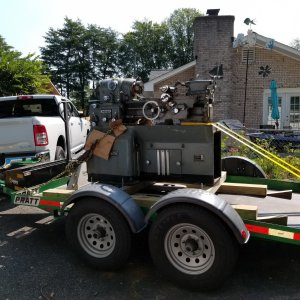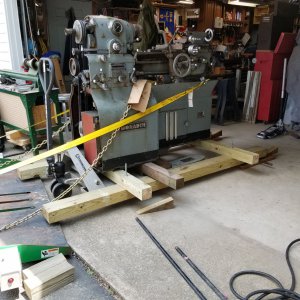A few things about 10EE that haven't been mentioned and "Why" the jealousy. This is a ramble, not well organized . . .
They were built to a use standard, not a "This is what we want to see it sell for." price. Companies like GE, Boeing, government contractors, knew exactly what they were getting when they decided to pay the price. Like as much as a home the, in those days, guy running it might live in. Today a factory re-maunfactured one is no different.
The Ward-Leonard Motor Generator drive takes AC and turns a DC generator mounted on the same shaft to run a separate DC motor in the headstock. On top of the MG is an "exciter" that will prime the DC generator to get it going. Occasionally if the exciter has set a long time it too will need to be primed with a 6v battery. There's a rotation arrow on it that will provide the clue if you got the legs wired up correctly. The belts are standard, and will often go on without needing to loosen anything which is good as then you don't have to realign the exciter and the MG.
The electro-mechanical drive control provides variable speed with uniform torque. You may have caught about losing low RPM torque when converting to an all AC drive. Many don't need the low speed torque so don't care. "But" the transmission has to be adapted to the replacement motor, nothing off the shelf, welding and machining skills required. Because the motor is isolated in the cast base that's heavy as heck and connected by belts to the headstock spindle, the work is very isolated from vibration. I honestly haven't had a chance to make chips with mine yet, cross country move. "But" trusting those who have run them they will turn that 10" "whatever" down to 9-1/2" with huge cuts and still leave a finish to drool over. Oh, the headstock spindle taper is a very unique and an interesting specification. You can look up the dirty details later. Grab any tooling that fits it! The tailstock is a #3 Morse Taper (MT), very easy to come by. Hopefully y9u are getting a nice tool post and holders with it.
It is quite possible to learn the nuances of a "trashed" machine and still make it work. |Good|Quick|Cheap| you can have any two. 1,000s of hobbyists have learned how to work around the worn parts of a machine and turn out fine work. Their time was cheap, and they got good. From what you have said, I seriously doubt this 10EE has been abused. Some parts do want to have due diligence taken, the correct modern day lube for the headstock bearings is one place and if the lathe has sat, changing the lube before it is run hard is TOP Priorty! You do not want to be replacing those babies. Some modern oils have very similiar names but are designed for different purposes. 100's of opinions, some decisions you will make and live with. There is an automatic way and cross slide lubrication system, "but" the metering ports are like an old school carburetor jets and the hole size matched to the lenght of the tube running to it. They have filters that CANNOT be cleaned or replaced. They are supposed to be replaced annually, so anticipate they will not work and you will be manually lubricating the ways and cross slide like you would probably have done if I hadn't mentioned this. They are a PIA to replace, more so if the copper tubing also has to be replaced. After that, getting them primed is also a royal PIA!
Some people like to make things and aren't all that wound about the paint like the hot rod that spends most of it's life primer gray. But don't bet pink slips

Some people take a great deal of joy making something look better and work at least as well than it did when it left the factory. I've read the story on the red example that was posted, it was like that. I mentioned the guy on PM with like 400 posts covering every detail of his round dial rebuild. And he's not done. But man is it going to look nice. He just finished hand relacing the wiring lume! Looks like it was done for NASA and it is tied with NASA spec. knots.
The lathes were used to make small very precise things. Like parts for bomb sites and nuclear weapons. Tools to make tools. One off prototypes. I've seen several posts by people in the medical device profession who still crank out "stuff" on the 10EE faster than the time necessary to get the CAD done and loaded into the CNC. Of course now days a rare breed. Called a 10" for the largest diameter of a piece of material that will fit, it is actually 12-1/2" but the bed is short, too short for many gunsmiths. Many lust after the few longer bed Monarch 10EEs made. Some were literally burred as nuclear waste after they became too contaminated making stuff some wish had never been created. There are some places on the lathe that do make your head shake. The taper attachment bracket is a known weak point and often broken or missing. The handles are all hand fitted with tapered pins, so like old British cars, anything new has to also be fitted. Or care taken when re-installing. There are places like the lead screw and shaft bearings that were often ignored because they were "lubricated for life." Right . . .
Oh, look and see if there is a metric thread plate on the headstock end cover. If there is, inquire very politely if someone could help you poke around and see if the $1,600 change gears are thrown in a cabinet. Even if there isn't a plate, I'd ask. I'm sick thinking DOD required a set with mine, they were probably thrown in a cabinet and later pitched when the lathe was declared surplus and no one remembered what they went too. Sadly all too common regardless of where the machine lived.
Monarch will sell you a manual that's mostly generic, but has any pages needed for how your lathe left the shop. Funny, the "Works in a Drawer" (WIAD) with the tubes are common in the wild. Not so the MG. I'd purchase one, "BUT" tell them you are not in a rush and don't need a $25 FedEx. That will lower the price considerably. Assuming they will do it for you. Some pages will be missing, they are as far as anyone can tell "unobtainabium." The manual was written for a different age, for people who were already experienced machinests, had a factory rep sent to show them how to run it, or a journeyman with know how. How to make it run is like 1/3 in and burred in the middle of a paragraph. The handle is by the chuck, and moving it to the left, counter clock wise, will make the lathe run counter clock wise.

To the right is not "forward."
If/when you need help with wiring and "we" here can't help you figure it out, Cal who moderates the PM board is the small ego, go to person who has many things squirreled away, had an interest in becoming a subject matter expert on the MG, and is more than willing to share. I felt fortunate to be able to pass on some schematics that came with my machine he'd not seen before. My machine was probably special built for DOD as a MG after the new stndard WiaD were in regular production. Conjector is at that time the MG was a well known product and DC on a ship was normal power. Don't need the WiaD. DOD and some other companies were powerful enough to get what they wanted made, but by then the MG parts were not as common. One of my resistors was the wrong size, I suspect because they only had what they had and the order sheet said as soon as the inspection was completed, the machine was to be prepared for long term storage. The "opise" wouldn't matter for a long time . . . At least you won't have to be reeducated on not assuming the MG is trash and the first thing to be replaced. Sometimes that is the smart way to go, but probably not in your case. In my case it was simply a matter of working through the well known problems, replacing the usual suspect corroded resistors, with the proper size, and putting a couple of wires back where they belonged. Moved in a ham handed troubleshooting attempt easy to see what was being tried that didn't work. Probably a "Hey you, make one more try to get that Monarch going before we send it to disposal." and the poor repair person not knowing where to find the resources needed. Assumption anyway.
OK, hope this helps you as much as it would have helped me to have in one read rather than nuggets cast through a few 100 posts in almost as many threads.
Ron


